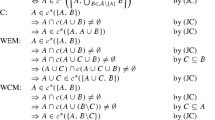Abstract
This paper presents a non-preference-based approach to the analysis of negative freedom. It is argued that a proper understanding of (different conceptions of) negative freedom necessitates an examination of the consequences of changes in the set of feasible alternatives. For this reason the paper does not focus on freedom rankings of opportunity sets but on freedom rankings of opportunity situations, i.e., pairs consisting of a feasible set and an opportunity set. Three different freedom rankings of opportunity situations are axiomatically characterised. Each of the three rankings forms a generalisation of the purely cardinality-based freedom ranking of opportunity sets presented by Pattanaik and Xu (1990).
Similar content being viewed by others
REFERENCES
Arrow, K.J. (1995), A note on freedom and flexibility, in K. Basu, P. Pattanaik and K. Suzumura (eds.), Choice, Welfare and Development. A Festschrift in Honor of Amartya K. Sen (pp. 7–16). Clarendon Press, Oxford.
Carter, I. (1992), The measurement of pure negative freedom, Political Studies 40: 38–50.
Carter, I. (1996), The concept of freedom in the work of Amartya Sen: an alternative analysis consistent with freedom's independent value, Notizie di Politeia: 43/44: 7–22.
Gravel, N. (1994), Can a ranking of opportunity sets attach an intrinsic importance to freedom of choice?, American Economic Review 84: 454–458.
Parent, W.A. (1974), Some recent work on the concept of liberty, American Philosophical Quarterly 11: 149–167.
Pattanaik, P.K and Xu, Y. (1990), On ranking opportunity sets in terms of freedom of choice, Recherches Economiques de Louvain 56: 383–390.
Pattanaik, P.K and Xu, Y. (1995), On preference and freedom (mimeo).
Puppe, C. (1995), Freedom of choice and rational decisions, Social Choice and Welfare 12: 137–153.
Puppe, C. (1996), An axiomatic approach to “Preference for Freedom of Choice”, Journal of Economic Theory 68: 174–199.
Sen, A.K. (1988), Freedom of choice: concept and content, European Economic Review 32: 269–294.
Sen, A.K. (1990), Welfare, freedom and social choice: a reply, Recherches Economiques de Louvain 56: 451–485.
Sen, A.K. (1991), Welfare, preference and freedom, Journal of Econometrics 50: 15–29.
Sen, A.K. (1993), Markets and freedoms: achievements and limitations of the market mechanism in promoting individual freedoms, Oxford Economic Papers 45: 519–541.
Steiner, H. (1983), How free: computing personal liberty, in A. Phillips-Griffiths (ed.), Of Liberty, (pp. 73–89). Cambridge: Cambridge University Press.
Van Hees, M. (1995), Rights and Decisions. Formal Models of Law and Liberalism. Dordrecht/Boston/London: Kluwer Academic Publishers.
Van Hees, M. and Wissenburg, M. (1997), Opportunity and freedom, Political Studies (forthcoming)
Author information
Authors and Affiliations
Rights and permissions
About this article
Cite this article
van Hees, M. On the Analysis of Negative Freedom. Theory and Decision 45, 175–197 (1998). https://doi.org/10.1023/A:1004938512267
Issue Date:
DOI: https://doi.org/10.1023/A:1004938512267



